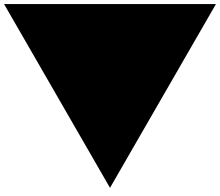Black triangle (badge)
The black triangle was a badge used in Nazi concentration camps to mark prisoners regarded "anti-social" and "arbeitsscheu" (work-shy). Those considered anti-social included alcoholics, homeless, Romani, beggars, nomads, and prostitutes.[1] Women deemed to be anti-social included sex-workers, nonconformists, and lesbians.[2] The term "asocial" was originally applied to heterosexual women who engaged in sex outside of marriage, which included prostitutes.

Usage

Nazi
The symbol originates from Nazi Germany, where every prisoner had to wear a concentration camp badge on their prison clothes, of which the design and color categorized them according to the reason for their internment. The homeless were included, as were alcoholics, those who habitually avoided labor and employment, draft dodgers, pacifists, Roma and Sinti people, and others.[3][4]
Lesbian
Nazis considered lesbians anti-social and a huge threat to the purity of German society, hence the badge was used to identify them.[5]
Disabled people
Some UK groups concerned with the rights of disabled people have adopted the symbol in their campaigns.[6][7] Such groups cite press coverage and government policies, including changes to incapacity benefits and disability living allowance, as the reasons for their campaigns.[8][9] "The Black Triangle List" was created to keep track of welfare-related deaths due to cuts by the Department for Work and Pensions.[10]
See also
References
- "System of triangles". Auschwitz-Birkenau State Museum.
- Heineman, Elizabeth D. (2002). "Sexuality and Nazism: The Doubly Unspeakable?". Journal of the History of Sexuality. 11 (1/2): 22–66. ISSN 1043-4070. JSTOR 3704551.
- "The unsettled, "asocials"". Holocaust and Genocide Studies. University of Minnesota. 2007. Archived from the original on 4 June 2008. Retrieved 14 September 2012.
- "Asocials". Holocaust Memorial Day Trust. Ministry of Housing, Communities and Local Government. Retrieved 23 June 2020.
- Elman, R. Amy (1996). "Triangles and Tribulations: The Politics of Nazi Symbols". Journal of Homosexuality. 30 (3): 1–11. doi:10.1300/J082v30n03_01. ISSN 0091-8369. PMID 8743114.
- "About Black Triangle". Black Triangle Campaign. March 2012.
- "About". Disabled People Against Cuts. 2010.
- Sue Marsh (20 December 2011). "No disability living allowance for me. Nowhere to turn for many more". Black Triangle Campaign.
- George Monbiot (12 December 2011). "Britain's press are fighting a class war, defending the elite they belong to". Black Triangle Campaign.
- Laws, Vince (30 April 2015). "UK Welfare-Related Deaths: The Black Triangle List". Disability Arts Online. Retrieved 30 July 2018.
Further reading
- Marshall, Stuart. "The Contemporary Use of Gay History: The Third Reich," in Bad-Object Choices (ed.), How Do I Look? Queer Film and Video, Seattle, Wash.: Bay Press, 1991.